It's the bike we've begged for, for over a decade. Is the Aprilia RS 660 the best bike from the Italian make yet? It could well be, or very close to it. Rennie checks it out Photography: Kevin Wing
Every now and then a motorcycle comes along that moves the goal posts for a given category. Think bikes like the KTM 790 Adventure R or Ducati Streetfighter V4 S, and you get what I mean. The 2021 Aprilia RS 660 falls into this category. Read our review to find out why…

The Aprilia RS 660 arrives Down Under in March 2021, with an expected price tag of $18,500 to $19,000 Ride Away.
We love sportsbikes here at Bikereview, and particularly Aprilia’s (who could forget Jeff’s RSX550, an RS250 with an SXV550 engine that he won an F3 title on and set multiple lap records), but over the years they’ve become stale, and, let’s face it, impractical. Oddly, the RS 660 is looking at the issue of razor-sharp sportsbikes through rose-tinted glasses, when sportsbikes weren’t solely designed to win on Sunday, sell on Monday.
The RS 660 is not the descendant to the legendary RS 250. That machine was the definition of that overused journalistic term racer-with-lights, whereas the RS 660 aims to bring the joys of a skinny chassis, punchy, light and fast revving twin-cylinder motor, and sporty ergonomics and character to a far wider audience than the RS 250 could ever have imagined.

Styling is on the money, unlike other street sports models, which are often more reserved and bland.
Utilizing a glorious 100hp parallel-twin four-stroke wrapped in an aluminium dual beam chassis with class-redefining electronics, the RS 660 is a bike for anyone with a sporting itch that needs scratching. The 57kg parallel-twin motor is the first middleweight V-twin (under 750cc) created by Aprilia since the powerful and plainly scary SXV450 and 550 twins from the early years of this century. It is essentially the front half of the RSV4’s 65° V4, measuring 81 x 63.93mm for 659cc—bang on for Twins racing that is taking off everywhere around the world except, sadly enough, in Australia…
Running a 270° crank that gives off a deep burble of an exhaust note, the motor runs a single gear-driven counterbalancer to reduce high rev vibrations, and uses a modular cam drive layout with a chain driven from an idler gear off the crank, which then operates the inlet cam in the DOHC head, and two more idler gears operate the exhaust cam. The spent gasses escape via the two-into-one exhaust that has the muffler placed directly under the swingarm pivot.

The 57kg parallel-twin motor is the first middleweight V-twin (under 750cc) created by Aprilia since the powerful and plainly scary SXV450 and 550 twins.
As for the top of the motor, you’ll see twin 48mm RbW throttle-bodies fed by an intake in the centre of the steering head, not to the side like the RSV4. The throttle body manifolds are different in length, helping give optimal air volume at low and high rpm.
The head contains eight valves, measuring 33mm on the inlet side and 26mm exhaust, with compression at a healthy 13.5:1. Power is claimed at 100hp at the crank, taken at 10,500rpm, while torque comes back at 67Nm at 8500rpm. Part of the goal with the motor was to make it as flexible as possible so it can be ridden just as easily on the street as the track, as such 80 per cent of the available torque is available from 4000rpm, with 90 per cent on tap from 6250rpm. Given the RS’s appetite for revs, you’re rarely below 5000rpm, so you’ve got go on tap so long as you don’t let engine speed drop below 3000rpm.
You’re helped in this regard by the six-speed gearbox mated to the up-and-down Aprilia Quick Shift System (AQS), part of a full rider suite of electronics that are a first for the class. The gearshift is delightfully smooth and reminiscent of the RSV4’s on which it’s modelled.
Yet, as flexible as that motor and gearbox, what makes the RS 660 so appealing is the chassis, ergonomics and rider aids. The die-cast twin-spar aluminium frame is skinny like Jenny Craig, with a near ideal level of sporting stiffness required for weekend track day scratches while remaining plush enough to help the Kayaba suspension soak up road corrugations on your way to work.

AQS (up and down quickshifter) is fantastic, lack of heel guards not so much. That seems quite an oversite by Aprilia.
The wheelbase is rather compact at 1370mm and matched to a 24.1° rake and 104mm trail, enough to help you max out your turn speed but keep a degree of stability at your fingers. There were slight changes between the final production RS 660 chassis and that which we saw debut at EICMA in 2018 in prototype form, with the main frame rails narrowed and the engine mounts moved closer to the steering head, helping tilt the motor forward and putting more weight on the front for better braking and cornering stability.

The RS 660 has basic suspension, hinting that there is a Factory version coming with full high end electronic kit.
The suspension is taken care of by fully-adjustable Kayaba 41mm inverted forks and a Kayaba monoshock out back, although the shock is not fully adjustable with rebound damping and preload adjustment only. The shock doesn’t run a linkage but acts directly on the swingarm, which in turn pivots inside the crankcase, helping centralise mass and reduce the wheelbase while still allowing the use of a relatively long swingarm.
Hauling you up from speed is the job of the twin radial-mounted Brembo four-piston monobloc calipers clamping down on 320mm discs. Braking power is fed by a radial master-cylinder and steel brake lines, while the rear gets a twin-piston caliper and a single 220 mm disc. Both ends are Cornering ABS-equipped. More on that in a tick.

320mm rotors, Brembo monoblocks, braided lines and a man child equals this! Awesome stopping power available.
The RS 660 needed to be usable every day, and that comes almost entirely down to ergonomics. This is not a typical head-down-bum-up sportsbike—the handlebars are clip-on style (not actual clip-ons) and sit higher than the steering head, placing the rider in a neutral, almost nakedbike ride position.
The handlebar position is complimented by lower set footpegs than would normally be expected for a sportsbike, although these annoyingly void of decent length heel guards so the backs of your boots will rub against the moving swingarm if you tuck your feet in. No doubt this is something the aftermarket will fix when rearsets become available, which is a good thing, considering the pegs are quite low and will touch down with high lean angles.
Regardless, the ride position is comfortable—three full days on this thing (including an all-night run through San Francisco) had me in far better shape than if I were on a real supersport bike.
Moving onto electronics, there’s everything the RSV4 gets and, believe it or not, more. You can’t vary engine brake control on the RSV4, but you can on the RS 660. That goes with everything available in the APRC (Aprilia Performance Ride Control) system of traction control, wheelie control, Cornering ABS, quick shifter, cruise control (yay!), pit lane speed limiter and of course, the five riding modes.

The electronics package even trumps the bigger siblings. It’s a truly impressive package for a sub $20k machine.
There’s three road modes (Commute, Dynamic and Individual) two for the track (Challenge and Time Attack), although truth be told the Individual and Time Attack modes are essentially the same thing, apart from having your lap timer on full view rather than the speedo. Individual and Time Attack are variable, so you can set them up with the levels of traction, wheelie, engine brake, etc, you want. The other modes (Commute, Dynamic and Challenge) all have pre-set levels of electronic intervention.

Gorgeous motorcycle but we reckon this switchblock is dead set ugly. It just doesn’t go with the rest of the fluid design…
This level of rider aids is not just a boon for the middleweight class but on par with what’s on offer for superbikes twice or three times the price, with only the pit lane speed limiter a factory option.
The company has chosen to go with Continental for the six-axis Inertial Measurement Unit and Cornering ABS electronics, and you also get Cornering lights/Daytime Running Lights with the turn signals integrated into the front of the bike. This is in part due to the aerodynamics that have been designed into the fairing, but it’s still a nice, clean aesthetic addition.

Premium touches, such as cornering LED headlights and self cancelling indicators, add to the roadbike capabilities.
The Ride
The thing that strikes you when you first climb on board an RS 660 is how skinny it is. The 15L tank width feels about half what it is compared to the RSV4, and the way it carries its weight, even when all you’re doing is standing flat footed in the parking lot, is impressive. Move out into the open road, however, and you realise immediately how right Aprilia has got this motorcycle.

“Keep the RS surfing between 6000 and 10,000rpm, and you’re met with constant drive and torque to pull you from one corner to the next, it is truly an addictive little engine”.
I had a small play around with the variable maps, including a cold morning jaunt in Commute mode just to experience the slightly dulled throttle response, but once in Individual mode with full throttle, level two engine brake, and switching off wheelie control (wink), the RS absolutely comes alive. Throttle response is perfectly metered—there’s no jerkiness from fully closed, but equally, the power doesn’t rush in uncontrollably.
At 100hp, it’s about the perfect level for modern Australian roads, given our love of revenue raising radar systems. There’s enough go to keep you entertained and enough go never to be bored by it.

“I had a small play around with the variable maps, including a cold morning jaunt in Commute mode just to experience the slightly dulled throttle response”…
You’ll want to make sure you change gear on the sweet action quick shifter before you crash into the harsh rev limiter at 11,500rpm, but by then you’ve run past where all the acceleration is. Keep the RS surfing between 6000 and 10,000rpm, and you’re met with constant drive and torque to pull you from one corner to the next. It truly is an addictive little engine.

“You can hammer through corners on the RS 660, and in my opinion it’s far more rewarding to get a corner right than it is to simply twist the wrist.”
The Kayaba fork has an impressive action, especially on the brakes. We didn’t touch the standard suspension settings all day, even though my 86kg frame would probably warrant a turn or two of rear preload on the track. On the road, however, the suspension action is plush while not turning the chassis into a wet noodle, allowing you to be forceful without understeering yourself off the road when you get back on the gas.
You can hammer through corners on the RS 660, and in my opinion it’s far more rewarding to get a corner right than it is to simply twist the wrist. The lack of overall weight compared to a bigger bike, and the skinny feel of the chassis, gives loads of confidence to the rider while cranked over.
Its turn speed is huge, partly due to the 5.5 inch rear wheel compared to the 6 inch units more commonly found on sportsbikes. You can throw the RS around and it just keeps coming back for more, and when you’re heading back home, just flick on the easy to use cruise control and tell the boys in blue they ain’t going to get you today…

“Once in Individual mode with full throttle, level two engine brake, and switching off wheelie control (wink), the RS absolutely comes alive.”
Rather than just making improvements we see every year to the status quo in the superbike and supersport bikes, Aprilia has taken a fresh approach to street sports biking. The RS 660 will launch a new line of bikes bearing the same engine, with a Tuono version coming next February and a Tuareg adventure bike to come by the end of the year. If both these bikes perform at the same level as the RS 660, the future for Aprilia is very bright indeed.
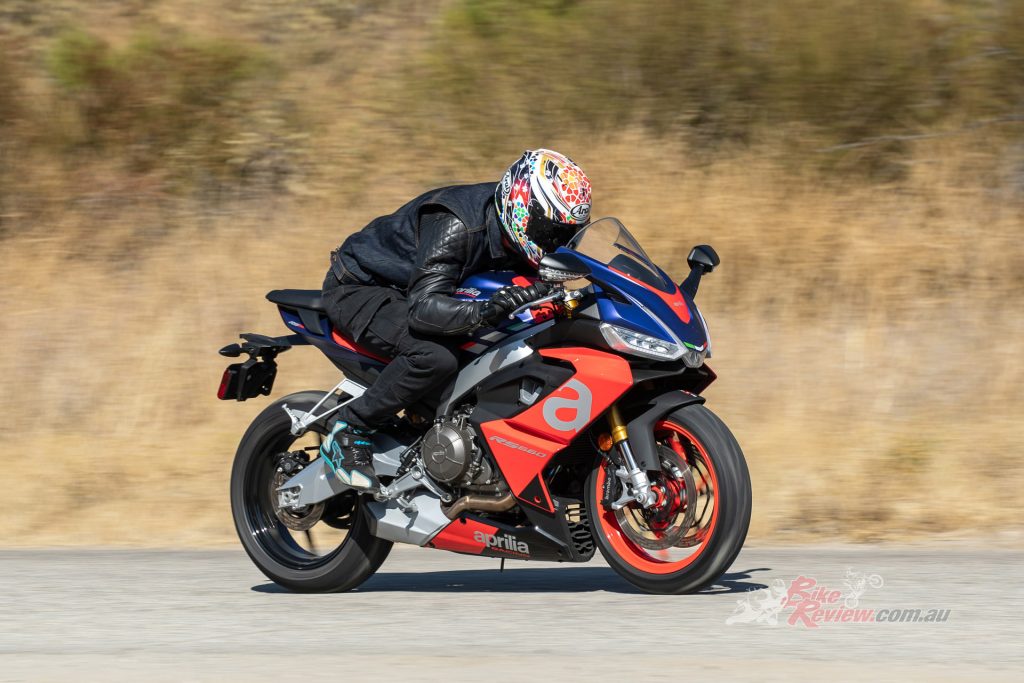
The RS 660 will launch a new line of bikes bearing the same engine, with a Tuono version coming next February and a Tuareg adventure bike to come by the end of the year.
It wouldn’t surprise us at all if we see Honda and especially Kawasaki begin to follow suite and put more effort into their middleweight machines, because, make our words, Aprilia will sell the RS 660 as fast as it can produce it. Road sport biking is back, ladies and gentlemen, and we are all the better for it. The RS 660 will be available here in March 2021 and priced around the $18,500 – $19k AUD mark. We will be doing a full, comprehensive road and track test here early next year, so keep an eye out.
2021 Aprilia RS 660 Specifications
aprilia.com.au
Price: $18,500 to $19,000 RRP R/A (TBC first 1/4 2021)
Claimed Power: 73.5kW[100hp]@10,500rpm
Claimed Torque: 67Nm[50lbs-ft]@8,500rpm
Wet Weight: 183kg (169kg dry)
Fuel capacity: 15L
Engine: Parallel twin-cylinder forward facing, four-stroke, 270-degree, eight-valve DOHC, liquid cooled, chain driven cams, 81 x 63.9mm bore x stroke, 659cc, 13.5:1 compression, two-into-one exhaust, ram air, twin 48mm throttle-bodies, RbW throttle and EMS.
Gearbox: Six-speed with AQS up and down.
Clutch: Wet multi-plate with mechanical slipper, cable actuation
Chassis: Dual beam alloy frame with removable alloy sub-frame
Rake: 24.1°
Trail: 104mm
Suspension: Kayaba 41mm inverted forks, preload and rebound adjustable, 120mm travel, alloy asymmetric swingarm, monoshock with spring preload and rebound adjustability, 130mm travel
Brakes: 320mm rotors (f), Brembo radial-mount four 32mm piston calipers and radial pump master-cylinder, stainless braided lines, ABS, 220mm rotor (r), Brembo twin 34mm piston caliper, ABS
Wheels & Tyres: Cast alloy six-spoke, 17 x 3.50in (f), 17 x 5.50in (r), 120/70 – 17, 180/55 – 17 Pirelli Diablo Rosso Corsa II tyres.
Dimensions
Wheelbase: 1370mm
Seat height: 820mm
Ground clearance: N/A
Overall width: N/A
Overall Length: N/A
Overall height: N/A
Instruments & Electronics: TFT display, Six axis IMU, APRC pack: AWC (wheelie control), ATC (traction control), AEB (engine brake control), AEM (power maps), ACC (cruise control), Cornering ABS.
2021 Aprilia RS 660 Gallery
The Verdict | Review: 2021 Aprilia RS 660 street sports
Awesome!
The new Aprilia RS 660 is a sensible street sportsbike that brings back the fun in performance motorcycling. Rennie tests the bike in California and comes back grinning. Check out our RS 660 review… Stay tuned for a full Aussie test.
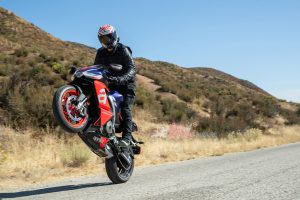





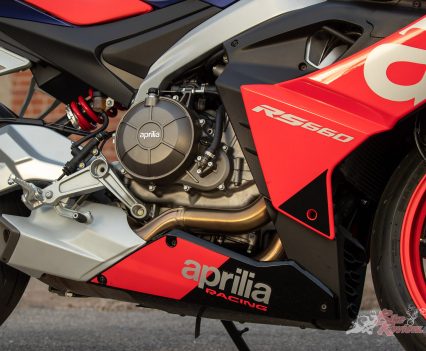





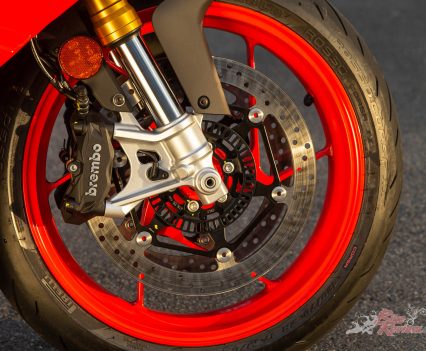









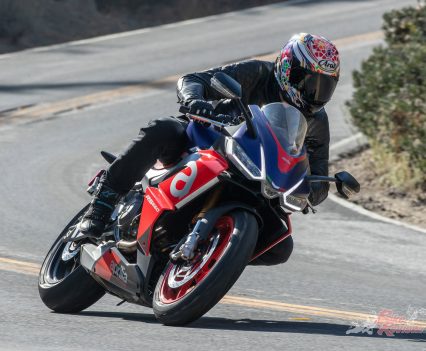





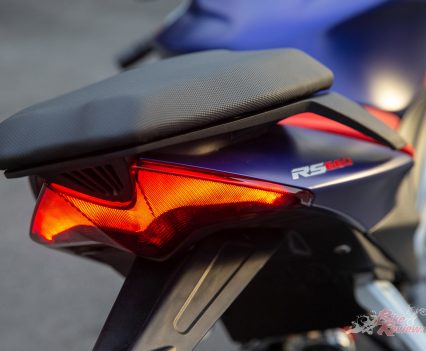










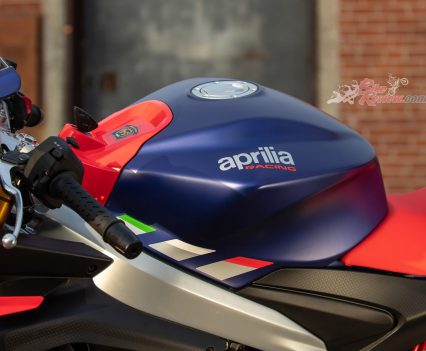



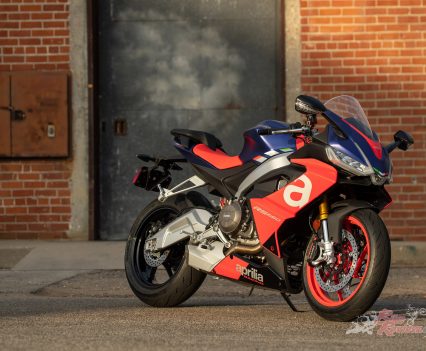




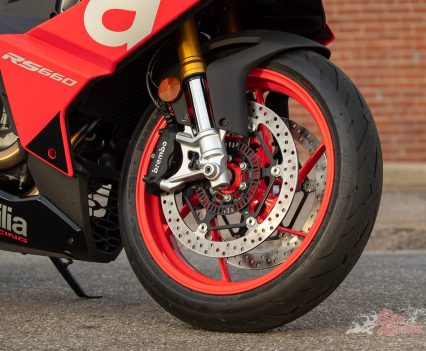


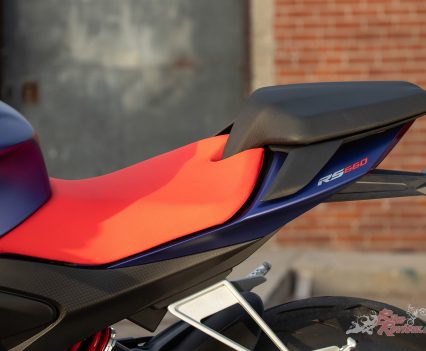








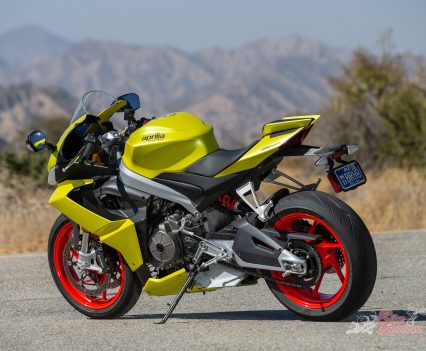




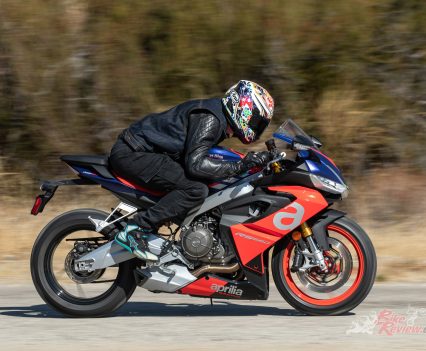




















November 4, 2020
I’m seeing nothing but glowing reviews for this. Hopefully the other manufacturers take note and give it some good competition.